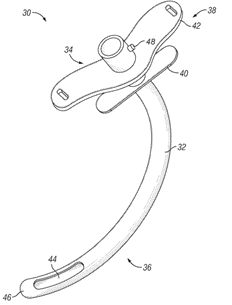Description:
Conventional airway management devices typically include an inflatable cuff that seals the tube within the trachea, while this inflated cuff design could place excessive pressure on the patient’s adjacent tissues and cause tissue damage. Although laryngeal mask airways (LMAs) can avoid potential damage to the trachea by providing a seal above the glottis, LMAs do not always form an adequate seal, and can place pressure on the pharynx, causing potential throat pain, nausea, and gag reflex.
UTHealth Inventor has designed an improved airway management device with a mouthpiece provided to form an airtight seal at the patient’s mouth, replacing the traditional inflatable cuff. This design can enable effortless blind insertion, avoid damage to the trachea and pharynx, and potentially minimize or avoid gastric insufflation.
Background
Conventional airway management devices during general anesthesia for a surgical procedure or for emergency airway access typically include an inflatable cuff that seals the tube within the trachea. However, the inflated cuff could place excessive pressure on the patient’s adjacent tissues and cause tissue damage.
LMAs utilize an elliptical mask at the end of a tube which forms a seal on top of the glottis, thus avoiding damage to the trachea. However, LMAs do not always form an adequate seal, and can place pressure on the pharynx, causing potential throat pain, nausea, and gag reflex.
Discovery
Dr. Yandong Jiang from UTHealth has developed a pharyngeal tube for establishing an airway within a patient, which comprises an elongated hollow tube including a mouthpiece at the proximal end of the tube to form an airtight seal at the patient's mouth. One or more lateral openings may be formed in the lateral wall of the hollow tube, while the distal tip of the hollow tube is sealed so that air cannot escape the tube from its distal tip (See Figure 1 below). This improved design can enable effortless blind insertion, avoid damage to the trachea and pharynx, minimize gastric insufflation, and has the potential to be widely applied in both general anesthesia and emergency airway access practice.

Figure 1 Schematic view of one embodiment of the pharyngeal tube design
Benefits/Technology Advantages
• Adequate airtight seal at patients’ mouth with the mouthpiece design
• Avoid damage to trachea and pharynx
• Effortless blind insertion
• Enables air influx to exit the tube and enter the pharynx and trachea
• Maintains pharyngeal patency and no air directed toward the esophagus, minimizing/avoiding gastric insufflation
• Allows gas expired from lung to be exhaled through the pharyngeal tube
Potential Applications
General anesthesia
Emergency airway access
Intellectual Property Status
Stage of Development
Clinical prototype is currently under development
About the Inventor
Yandong Jiang, MD, PhD, is a Professor of Clinical Care and Pain Medicine in the Department Of Anesthesiology at McGovern Medical School at UTHealth Houston. He has been a practicing anesthesiologist for 20+ years.
UTHealth Ref. No: 2019-0020